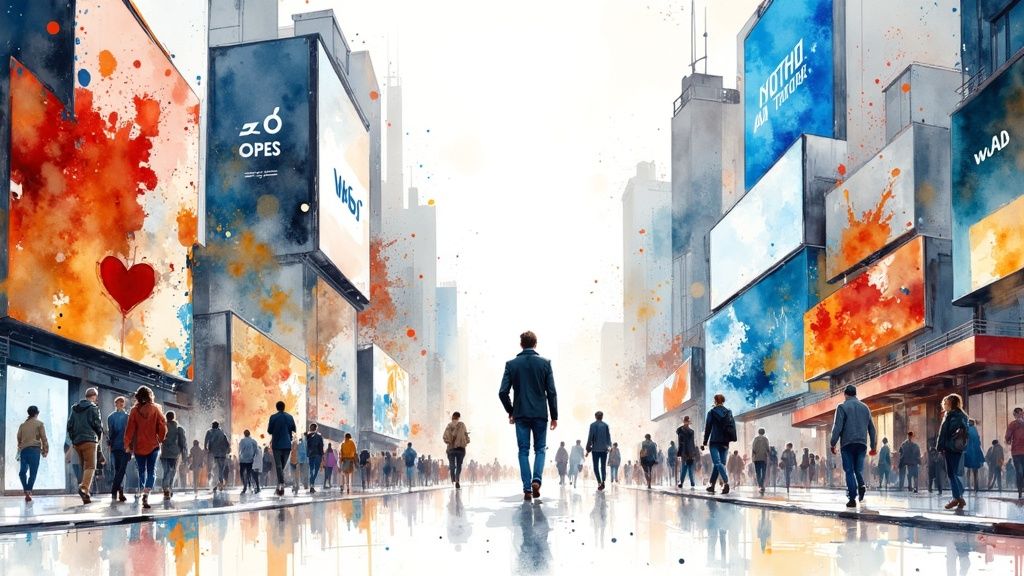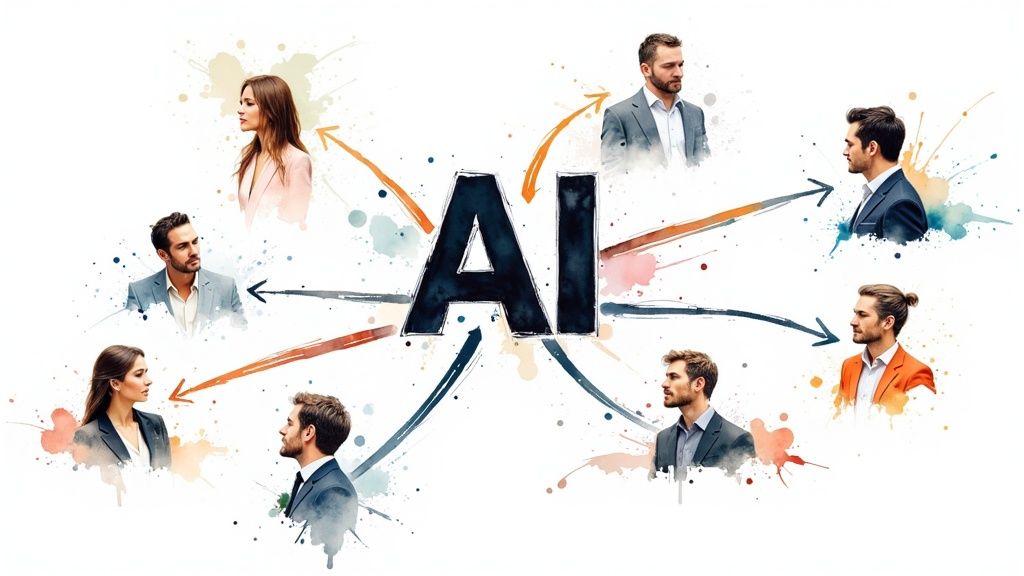Understanding the AI Revolution in Modern Advertising

AI is fundamentally changing how advertising works, going far beyond just automating basic tasks. We're seeing real shifts in how brands connect with audiences and run campaigns. For instance, AI now handles media buying and campaign optimization automatically, giving marketers more time to focus on creative strategy. This means companies can run more sophisticated campaigns backed by data, while maintaining efficiency and personal relevance.
How AI and Advertising Work Together
At its core, AI excels at processing massive amounts of customer data to spot patterns and insights that humans simply couldn't find on their own. This capability allows for truly personalized ad experiences at scale - each viewer gets content that speaks directly to their interests and needs. Think of AI as a smart assistant that knows your audience deeply and can tailor messages specifically for them. But with this power comes the need for careful consideration of how we use it.
Key Areas Where AI Is Transforming Advertising
AI is making its mark on advertising in several important ways:
- Improved Targeting: AI systems analyze user behavior to identify specific audience segments, helping ads reach the right people at optimal times.
- Enhanced Personalization: Ads can now adapt their content based on individual user preferences, leading to better engagement.
- Automated Campaign Optimization: AI constantly monitors and adjusts campaign settings in real-time based on performance data.
- Content Creation: AI tools can help create ad copy, images, and videos more quickly, allowing creative teams to spend more time on strategy and refining the output for better results.
The Challenges and Opportunities of AI in Advertising
While AI offers significant benefits for advertising, it also presents some key challenges. Data privacy and ethical AI use remain top concerns. There's also the question of how AI adoption might affect jobs in the industry. However, these challenges create new opportunities too. We're seeing new roles emerge for specialists in AI ethics and governance. Marketing teams are developing new skills to work effectively with AI systems. The future isn't about replacing human creativity - it's about combining human insight with AI capabilities to create better advertising. This partnership between human expertise and AI technology will be essential for success in modern advertising.
Making AI Implementation Actually Work
While AI presents compelling opportunities for advertising, turning potential into real results requires strategic execution and planning. Many organizations find themselves stuck between understanding AI's possibilities and actually putting it to work. Let's explore proven solutions that leading agencies and brands use to bridge this gap and build lasting AI programs.
Building a Foundation for AI Success
Getting AI implementation right starts with establishing core fundamentals:
-
Team Training and Confidence: Skip the theoretical lectures - teams need hands-on practice applying AI to their actual work. Show them exactly how AI can simplify tedious tasks like report creation. When people see AI making their jobs easier, adoption follows naturally.
-
Ethical AI Policies and Governance: Clear guidelines around data privacy, bias monitoring, and transparent AI decision-making protect both the organization and customers. Having these guardrails in place from the start prevents problems down the road.
-
Quality Control in AI-Assisted Workflows: While AI boosts efficiency, human oversight remains essential. Marketers need to review AI outputs, catch any issues, and ensure everything aligns with brand standards. The magic happens when AI and human expertise work together.
Overcoming Common Implementation Challenges
Most organizations face a few key hurdles when rolling out AI:
-
Resistance to Change: Team members often worry AI will replace their jobs. Open communication about how AI enhances rather than eliminates roles helps ease these fears. Show concrete examples of AI freeing up time for more strategic work.
-
Lack of Clear Objectives: Without specific goals, it's impossible to measure if AI is actually helping. Define what success looks like upfront - whether that's faster campaign launches, better targeting, or higher ROI.
-
Data Integration Issues: AI needs clean, connected data to deliver results. Getting data flowing smoothly between systems might require new tools or custom solutions. Prioritize fixing these foundation pieces early.
Strategies for Sustainable AI Integration
Build for the long-term with these proven approaches:
-
Start Small and Scale Gradually: Pick one focused area to implement AI first. Let teams gain confidence and work out issues before expanding. Early wins build momentum for wider adoption.
-
Focus on Measurable Results: Track clear metrics that show AI's impact on marketing performance. Real data helps justify continued investment and expansion of AI programs.
-
Foster a Culture of Continuous Learning: AI capabilities keep growing. Encourage teams to stay current through ongoing training and testing of new tools and tactics. For inspiration, check out The Top 10 AI Implementations of 2024 in Media and Marketing
By taking this practical, step-by-step approach, organizations can successfully integrate AI into their advertising operations. The key is balancing ambitious goals with careful execution - keeping humans at the center while letting AI handle what it does best. When done right, the combination delivers breakthrough results that neither could achieve alone.
Creating Exceptional Campaign Results With AI

The most effective advertising teams are moving beyond basic automation to build smarter marketing systems powered by AI. This shift requires rethinking how campaigns are planned, run, and measured to achieve better outcomes. Let's explore how leading brands are using AI to improve their advertising results.
Advanced Audience Targeting With AI
AI has dramatically improved how advertisers find and reach their ideal customers. Rather than relying on broad demographic segments, AI analyzes detailed data like browsing patterns, purchase history, social interactions, and location information to identify specific audience groups with shared interests and behaviors. For instance, an AI system might notice that people who visit camping websites and follow outdoor brands are more likely to buy hiking gear. This precise targeting means ads reach people who actually want to see them, leading to higher engagement and more sales from the same ad budget.
Real-Time Campaign Adjustments: The Power of Dynamic Optimization
One of AI's biggest advantages is its ability to optimize campaigns instantly based on performance data. Instead of waiting days to analyze results and make changes manually, AI systems can spot underperforming ads within minutes and automatically adjust things like bid amounts, audience targeting, or even the ad creative itself. This constant fine-tuning helps campaigns steadily improve over time rather than staying static.
Predictive Performance Modeling: Forecasting Success With AI
AI also helps advertisers predict which strategies will work best before launching campaigns. By studying patterns in past campaign data, AI builds models that forecast how different approaches might perform. This helps marketing teams focus their spending on the tactics most likely to succeed. For example, AI might identify that video ads on social media tend to convert better than display ads for a particular product category, allowing advertisers to plan their channel mix accordingly.
Balancing AI Insights With Human Judgment
While AI provides powerful data analysis and automation, human judgment remains essential. AI excels at finding patterns and optimizing metrics, but it can't fully grasp the subtle emotional aspects of advertising or broader brand strategy. The most successful campaigns combine AI's analytical capabilities with human creativity and strategic thinking. For instance, AI might identify the best times to show ads, while humans craft the compelling messages that resonate with audiences. You might be interested in: AI in Advertising: The Future is Now and It's Pretty Smart. This balanced approach - using AI to enhance rather than replace human expertise - is what delivers truly outstanding campaign results.
Mastering Generative AI for Creative Excellence
Generative AI opens up exciting new possibilities for creative advertising beyond just automating basic tasks. Tools like ChatGPT and DALL-E enable advertisers to explore fresh creative directions while staying true to their brand identity and quality standards.
Reimagining Content Creation With Generative AI
AI language models like ChatGPT are changing how marketing teams create content. These tools can quickly produce various types of copy - from social posts to long-form articles - which frees up human creatives to focus on strategy and adding their unique creative perspective. For instance, teams can use AI to generate multiple versions of ad copy for testing, making campaign optimization much faster and data-driven.
Visual Storytelling Enhanced by AI
Image generation tools like DALL-E give teams powerful new ways to create visuals. Whether you need custom social media graphics or blog post illustrations, AI can generate high-quality visuals that match your brand style. This means smaller businesses can now access professional-grade visuals without a big design budget. AI can also help personalize existing images to better connect with different audience segments.
Maintaining Brand Voice and Consistency
When using generative AI for advertising, keeping a consistent brand voice across channels is crucial. While AI can create content quickly, it needs clear guidance to match established brand guidelines. Think of it like training a new team member - providing detailed examples and style guides helps ensure AI-generated content stays on-brand. Learn more in our article about Revolutionizing Advertising: Unleashing the Power of AI Ad Creative. Regular human review and refinement keeps the AI output aligned with your brand voice and audience needs.
Ideation and Brainstorming: A New Partner in Creativity
One of the most valuable applications of generative AI is sparking new creative ideas. Marketing teams can input keywords, concepts, or competitor examples to generate fresh campaign concepts, taglines, and marketing approaches. Rather than replacing human creativity, AI acts as a collaborative partner - helping break through creative blocks and inspiring new directions. This partnership between human insight and AI's data-driven suggestions leads to more impactful, effective campaigns that resonate with audiences.
How people naturally consume content, considering the flow, pacing, and transitions:
Smart Investment Strategies for AI Advertising

Getting the most value from AI in advertising takes careful planning and strategic thinking. Success comes not from simply buying the latest tools, but from making smart choices about where and how to invest your resources. The key is understanding which AI capabilities will drive real results for your specific advertising goals and having clear ways to measure their impact.
Identifying Key Areas for AI Investment
Before investing in AI, take time to analyze where it can make the biggest difference in your advertising operations. Some companies find their top priority is using AI to better target and reach their audience. Others focus first on using AI to create and test ad content more efficiently. By identifying your most pressing needs, you can ensure your AI investments directly support your business objectives.
Here are the main areas where AI can strengthen your advertising:
- Data Analysis and Insights: Tools that process vast amounts of data to spot trends and guide strategy
- Automated Campaign Optimization: Systems that fine-tune campaign settings in real-time for better results
- Personalized Content Creation: Software that creates custom ad content based on user preferences
- Customer Service and Chatbots: AI assistants that handle customer questions around the clock
Budgeting for AI in Advertising
A practical budget approach is essential when adding AI to your advertising mix. Many companies start with a small pilot project, perhaps using 5% of their ad budget to test an AI optimization platform. As the pilot shows positive returns, they gradually expand their AI investment to other areas. This measured approach helps minimize risk while proving the value of AI tools.
Measuring the ROI of AI Advertising Investments
Clear metrics are vital for understanding if your AI investments are paying off. Start by setting specific performance goals and KPIs that match your business objectives. While traditional metrics like conversion rates and click-through rates matter, AI also lets you track deeper engagement signals - how long people spend on your site, whether they finish watching videos, or if they share content socially. Looking at both standard and advanced metrics gives you a complete picture of AI's impact.
Building a Flexible AI Investment Strategy
The AI advertising world keeps changing, so your investment approach needs to stay nimble. This means regularly evaluating your current AI tools while staying open to promising new options. It also requires helping your team build the skills to work effectively with AI as capabilities grow. For example, you might set aside part of your budget specifically for testing emerging AI tools that could give you an edge. Taking this flexible, forward-looking approach helps ensure your AI investments keep delivering value as technology advances.
Future-Proofing Your AI Advertising Strategy

Success with AI in advertising requires looking ahead rather than just reacting to changes. By understanding where AI technology is headed and building flexible strategies now, businesses can set themselves up for long-term growth. The key is creating systems and approaches that can grow and adapt as new capabilities emerge.
Identifying Emerging Trends in AI and Advertising
Several major shifts are reshaping how AI works in advertising. For instance, AI-powered contextual advertising now allows ads to be placed based on what users are doing in real-time, not just who they are. We're also seeing AI get much better at personalizing ads for individual preferences and behaviors, beyond basic demographic targeting. This increased personalization means advertisers need to focus more on protecting user privacy and using AI responsibly.
Adapting to the Evolving Landscape of AI and Advertising
Staying current requires an active commitment to learning and testing. Marketing teams should regularly explore new AI tools and capabilities through small pilot projects. Even modest experiments can reveal valuable insights about what works. The key is measuring results carefully to understand which AI approaches deliver real value and deserve further investment.
Building a Sustainable AI Advertising Framework
A lasting AI strategy needs strong fundamentals in several areas:
- Data Strategy: Clear processes for gathering and analyzing data in ethical ways
- Talent Development: Training teams to work effectively with AI tools and interpret results
- Ethical Considerations: Guidelines for responsible AI use and addressing potential biases
- Technology Integration: Smooth connection between AI capabilities and existing marketing systems
These elements work together to create a foundation that can grow over time. The framework should be reviewed and updated regularly as technology and consumer behavior change.
Maintaining a Competitive Edge With AI
Getting ahead takes more than just using the latest AI tools - it requires creative thinking and continuous testing of new approaches. This could mean exploring different ad formats or finding novel ways to reach audiences through AI. Building a culture where teams feel empowered to try new ideas with AI often leads to more engaging and successful campaigns. The goal is to keep testing and learning while staying focused on creating real value for customers.
Ready to take your advertising to the next level with AI? Aeon, helps publishers turn text, video, and audio into compelling video content. The platform uses AI to automate video production while ensuring your brand's standards and editorial control. Visit https://www.project-aeon.com to see how Aeon can help you achieve your advertising goals through smart use of AI technology.